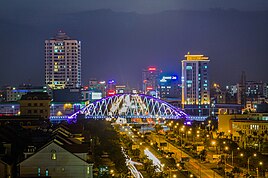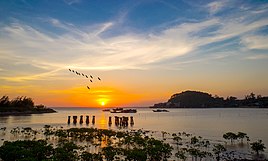Haiphong
Hải Phòng | |
|---|---|
| City of Haiphong Thành phố Hải Phòng | |
From top, left to right: Downtown Haiphong, Haiphong seen from Haiphong Opera House, Lê Chân statue, Nguyen Binh Khiem overpass, Hai Phong Port, Đồ Sơn. | |
| Nickname: Flamboyant City (Thành phố hoa phượng đỏ) | |
 | |
 Provincial location in Vietnam | |
| Coordinates: 20°51′54.5″N 106°41′01.8″E / 20.865139°N 106.683833°E | |
| Country | |
| Region | Red River Delta |
| Seat | Hồng Bàng |
| Subdivision | 8 urban districts, 1 municipal city, 6 rural districts |
| Government | |
| • Type | Municipality |
| • Body | Haiphong People's Council |
| • Secretary of the Party | Trần Lưu Quang |
| • Chairman of People's Council | Phuong Giang Hồ |
| • Chairman of People's Committee | Nguyễn Văn Tùng |
| Area | |
| 1,526.52 km2 (589.39 sq mi) | |
| Population | |
| 2,310,280 | |
| • Density | 1,500/km2 (3,900/sq mi) |
| • Urban | 1,432,079 |
| Ethnic groups | |
| • Vietnamese | 99.6% |
| • Others | 0.4% |
| Time zone | UTC+07:00 (ICT) |
| Postal code | 04xxx–05xxx |
| Area codes | 225 |
| License plate | 15, 16 |
| GRP (Nominal) | 2020[5][6] |
| - Total | US$12 billion |
| - Per capita | US$5.863 |
| HDI (2022) | (4th) |
| Climate | Cwa |
| International airport | Cat Bi International Airport |
| Website | en |
Haiphong (Vietnamese: Hải Phòng) is the third-largest city in Vietnam and is the principal port city of the Red River Delta.[8] The municipality has an area of 1,526.52 km2 (589.39 sq mi),[1] consisting of 8 urban districts, 6 rural districts and 1 municipal city (sub-city). Two of the rural districts cover islands in the South China Sea: Bạch Long Vĩ and Cát Hải. It has a population of 2,130,898 in 2023.[9][10] The city's economy has strength in manufacturing, as evident by large industrial parks and numerous smaller traditional handicraft villages. Historically, Haiphong is the first place in Vietnam and Mainland Southeast Asia to get electricity.
In the imperial era of Đại Việt, the Bạch Đằng River in Haiphong was a place of many legendary victories, led by now-legendary commanders Ngô Quyền and Trần Hưng Đạo. In the 16th century, Mạc dynasty has promoted the coastal settlement as a secondary capital, growing to become an important port town of Đàng Ngoài. After the French conquest of Vietnam, in 1888, the president of the French Third Republic, Sadi Carnot, promulgated a decree to establish Haiphong as one of the principal cities of the French Indochina. From 1954 to 1975, Haiphong served as the most important maritime city of North Vietnam. It was one of directly controlled municipalities of a reunified Vietnam with Hanoi and Ho Chi Minh City in 1976. In the 21st century, Haiphong is under active land reclamation, the most recent effort being the construction of South Đình Vũ dike in 2022.
Haiphong is a popular seaside vacation spot and known for biological reservations in Cát Bà Island. For its extensive port, the city hosts the headquarter of Vietnam People's Navy. Royal poinciana are commonly associated with Haiphong in Vietnamese culture.
- ^ a b Biểu số 4.2: Hiện trạng sử dụng đất vùng Đồng Bằng Sông Hồng năm 2022 [Table 4.2: Current land use status in the Red River Delta in 2022] (PDF) (Decision 3048/QĐ-BTNMT) (in Vietnamese). Ministry of Natural Resources and Environment (Vietnam). 18 October 2023. – the data in the report are in hectares, rounded to integers
- ^ "Hơn 2.200 tỉ đồng xây dựng đê biển Nam Đình Vũ, Hải Phòng". TUOI TRE ONLINE (in Vietnamese). 2022-11-17. Retrieved 2024-01-09.
- ^ General Statistics Office of Vietnam (2023). Niên giám Thống kê Việt Nam năm 2022 [Statistical Yearbook of Vietnam 2022] (PDF). Statistical Publishing House (Vietnam). p. 105. Archived (PDF) from the original on 2024-04-03. Retrieved 2024-04-03.
- ^ General Statistics Office of Vietnam (2019). "Completed Results of the 2019 Viet Nam Population and Housing Census" (PDF). Statistical Publishing House (Vietnam). ISBN 978-604-75-1532-5.
- ^ "Kinh tế - xã hội thành phố Hải Phòng giai đoạn 2016-2020 tạo đà và bứt phá" (in Vietnamese). Con số và sự kiện. 2021-03-22.
- ^ "Thu nhập người Hải Phòng: 11.800 USD/năm vào 2025". Tuổi Trẻ. 15 October 2020.
- ^ "Human Development Index by province(*) by Cities, provincies and Year". General Statistics Office of Vietnam. Retrieved September 28, 2024.
- ^ "DEEP C - Living and Working in Vietnam". Archived from the original on 2020-06-25. Retrieved 2020-06-22.
- ^ https://giadinh.suckhoedoisong.vn. "Hưởng ứng ngày Dân số Việt Nam: Hải Phòng hoàn thành vượt mức các chỉ tiêu Trung ương và thành phố giao". giadinh.suckhoedoisong.vn (in Vietnamese). Retrieved 2024-10-27.
{{cite web}}: External link in|last= - ^ "Đẩy mạnh các hoạt động nâng cao chất lượng dân số". anhp.vn (in Vietnamese). Retrieved 2024-10-27.



